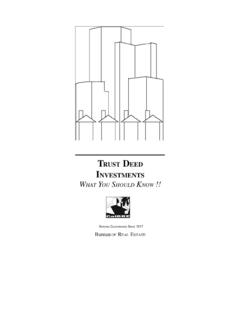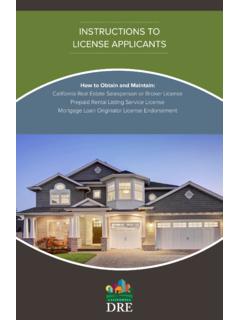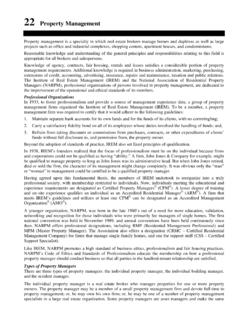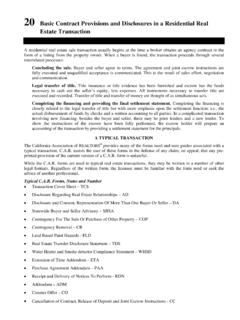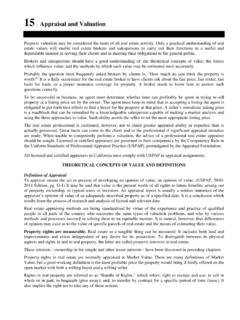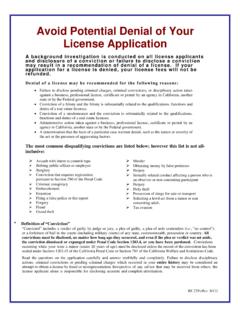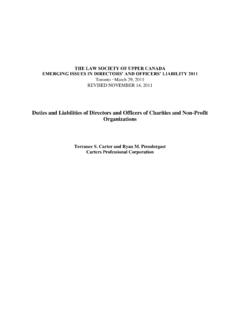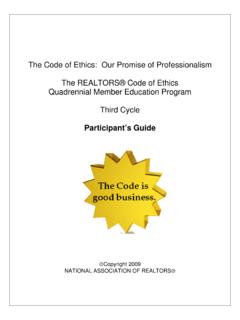Transcription of Living in a California Common Interest Development
1 Living IN A California . Common Interest Development . Living in a California Common Interest Development was originally developed in January 1999. by the California Association of Community Managers, Inc., working with the Department of Real Estate (DRE/Department). This booklet was revised in August 2002. and June 2016 by the Department. PREFACE. This booklet is designed to provide general information in response to some of the more frequently asked questions regarding Living in a Common Interest Development (CID).
2 We hope it contributes to your understanding and expectations of home ownership in a CID. Since this brochure does not contain specific legal information or guidance, it should only be used as a general source of information. If you want to research the subject matter further, you may wish to consult with an attorney or an industry professional experienced with CIDs. QUESTIONS ABOUT Living IN A California . Common Interest Development . What is a Common Interest Development (CID)? A CID is descriptive not only of a certain type of real estate and form of home ownership, but also of a lifestyle that has become more and more Common to the American way of life.
3 To understand the concept, it is important to know that there is no one structural type, architectural style, or standard size for CIDs. They come in a variety of types and styles, such as single-family detached houses, two-story townhouses, garden-style units with shared party walls, and apartment-like, multistory high rises. In California , there are tens of thousands of CIDs that range in size from a simple two-unit Development to a large complex having thousands of homes, many commonly owned facilities, and multiple associations under the auspices of one overall master association.
4 However, despite the wide range of differences that may exist among CIDs, all CIDs are similar in that they allow individual owners the use of Common property and facilities and provide for a system of self-governance through an association of the homeowners within the CID. The most Common type of association of homeowners is the nonprofit mutual benefit corporation. This is a corporation in which the members of the corporation vote for a board of directors that run the affairs of the corporation. However, some associations, usually the older ones, are unincorporated associations.
5 In many ways, unincorporated associations are treated the same as mutual benefit corporations under California law. Do you have to join the association? Membership in the association(s) is automatic. When a person buys a lot, home, townhouse, or condominium in a Common Interest Development , he/she automatically becomes a member of the association(s). Living in a California Common Interest Development 1. What are Covenants, Conditions and Restrictions (CC&Rs)? The Declaration of the Covenants, Conditions and Restrictions, or CC&Rs, contains the ground rules for the operation of the association.
6 This governing document identifies the association's Common area and responsibilities, explains the obligation of the association to collect assessments, as well as the obligation of the owners to pay assessments. It also states that the association may sue owners for violations of the rules or failure to pay assessments, and explains what happens if there is any destruction of property in the Development as a result of fire or earthquake. The CC&Rs will also state the duties and obligations of the association to its members, insurance requirements, and architectural control issues.
7 How are the CC&Rs enforced? California laws allow that either the association or an owner in a Common Interest Development may file a lawsuit asking the court to enforce the CC&Rs. The law currently requires, with some exceptions, that either the owner or the association must offer to engage in some form of alternative dispute resolution process before filing a lawsuit. You may wish to consult with an attorney who specializes in this type of law if you are faced with or contemplating an enforcement matter.
8 What are bylaws? As stated above, the CC&Rs generally state how an association is to be operated. In almost every instance the association, through its board of directors, has the ultimate responsibility for managing the association. As the association is usually a corporation, bylaws establish the rules by which the corporation will be run. Bylaws usually set forth how members vote for the board of directors, the number and term limit of members of the board of directors, the duties of the board, the duties of the officers, and other incidental provisions.
9 2 California Department of Real Estate Does the Department of Real Estate assist with the enforcement of the bylaws and CC&Rs? CIDs are subject to the Davis-Stirling Common Interest Development Act ( California Civil Code sections 4000 et seq.). This Act is intended to provide homeowners with a system of self-government and dispute resolution. The Department of Real Estate reviews the legal framework of all new CIDs to ensure compliance with the Subdivided Lands Law as part of the public report application process before homes are offered for sale to the public.
10 Once sales have commenced, the Department's jurisdiction is limited to the subdivider's obligations under the public report, which does not include intervention in association disputes. Presently, there is no State or local agency that directly regulates associations or their members. Who is in charge of the association? The homeowners are in charge of the association. Often, homeowners will elect a board of directors to operate the association and preserve, enhance, and protect the value of the CID, but the board answers to the homeowners.

